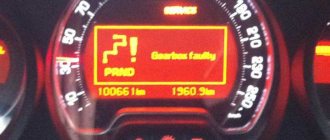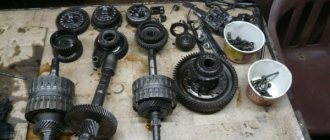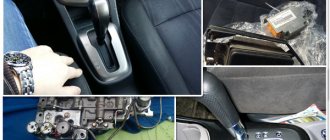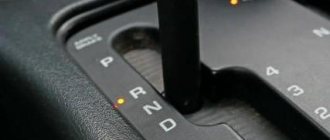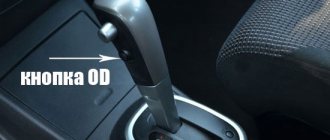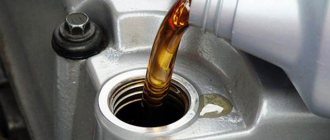Very often you hear from drivers who primarily own cars with a manual transmission that an automatic transmission is a complete problem. Maintenance is expensive, and you will also have to fork out money for repairs. In addition, such a car cannot even be towed.
Of course, this is partly true. However, anyone who has driven an automatic transmission at least once will admit that automatic transmission makes life much easier for the driver, especially in city traffic and traffic jams. And as you know, you have to pay for convenience. And if you figure out why you can’t tow a car with an automatic transmission, you’ll find out that not everything is so bad. And there are exceptional cases.
What is an automatic transmission
An automatic transmission is one of the types of transmission in which the required gear ratio is automatically selected without driver intervention, taking into account the nature of the movement, speed and other parameters.
In a car with an automatic transmission, there is no clutch pedal due to the fact that the clutch is replaced by a torque converter, which transmits torque to the wheels.
Starting a car with automatic transmission
To ensure the safety of the automatic transmission, several types of protection are provided in the car.
To start the car engine, the selector lever must be in the Parking (P) or N eutral (N) position. When the selector is in other modes, starting the engine will be impossible, since either the key will not turn or nothing will happen at all.
Due to the fact that the “N” mode is intended by the manufacturer mainly for towing the car, it is preferable to use the “P” mode to start the engine, in which the drive wheels are locked, which protects against unplanned movement of the vehicle on an inclined surface.
Another important protection against improper starting of the car is the need to depress the brake pedal, which is very useful when starting the car in the selector position on “N”, since the pressed brake pedal will prevent the car from rolling when it is on an inclined surface.
Modern cars have additional types of protection to prevent theft. If, despite following all the steps to start the engine correctly, the key in the ignition switch cannot be turned and the steering wheel also does not respond to attempts to turn it, the anti-theft protection has turned on.
To remove it, you must carefully turn the key while turning the steering wheel in any direction. With coordinated actions, the theft protection will turn off and the car will be able to start.
How to start automatically
After starting the engine, the car must be released from the handbrake.
To start driving with the brake pedal depressed, you must move the selector to one of the positions by pressing the button on it:
- “D” - forward movement under normal conditions;
- “R” - reversing if maneuver is necessary;
- “L” or “D2” - for off-road driving, when the car is on a significant slope at the moment it starts moving, the maximum permitted speed for such modes is less than 40 km/h;
- “D3” - if necessary, move down a small hill;
- “S”, “W”, “*”, “Hold”, “Winter” - winter mode, for starting and driving on snow with a reduced probability of slipping of the drive wheels.
After releasing the brake pedal, the car will begin to move even without pressing the accelerator (gas) pedal.
In severe frosts, before driving after a long period of parking in a cold place, it is necessary to allow the engine and transmission to warm up for 6-10 minutes.
How to brake with an automatic engine
With automatic transmissions, you can use engine braking, but this process differs from manual transmissions.
To apply engine braking, depending on the conditions, you must select the following selector positions:
- if there is an “O/D” button at a speed below 110 km/h, it can be pressed to smoothly brake the engine and limit the speed to 80 km/h;
- “L”, “D1” or “D2” when driving off-road with descents and ascents at a large angle, these modes allow you to use maximum power and limit the speed to 20-50 km/h (L, D1), 40-80 km/h h(D2);
- “D3” - movement up to 3rd gear at speeds up to 100-110 km/h;
Stopping at a traffic light or in a traffic jam
If you need to stop at a traffic light or in a traffic jam, then the torque break from the engine shaft to the automatic transmission is ensured by the actuation of the fluid coupling (HF) in the torque converter (CT).
Question answer
Why can’t you drive a “robot” the same way as a regular automatic transmission? This technical unit operates due to the driving and driven blade wheels, which rotate in transmission oil and transmit torque by transferring thick oil from one wheel to the blades of the other. The working fluid, under the influence of centrifugal force, is thrown off the blades of the drive wheel, falls on the blades of the driven wheel and, due to the transmitted kinetic energy, spins the input shaft of the automatic transmission, rigidly connected to the coupling.
There is no direct mechanical connection between the shaft from the engine and the input shaft of the machine. Therefore, if you press the brake at low speed, the car will stop, and the torque will simply go into the viscous fluid coupling oil, mixing and heating it. Excess heat is removed by the cooling system, and so the car can stand for a long time without negative consequences for the transmission.
Therefore, unlike robotic gearboxes, there is no need to put the automatic transmission into neutral (N) at every stop or put it in park (P). Moreover, this is even contraindicated and is fraught with rapid breakdowns.
What not to do with automatic transmission
Despite the fact that an automatic transmission seems easy to operate and is designed to make driving easier, there are still restrictions and prohibitions, adhering to which, the automatic transmission will last a long time and without complaints.
Restrictions and prohibitions when driving with an automatic transmission:
- Driving with a cold automatic transmission should be smooth, the first 6-10 km at low speed. It is necessary to warm up the automatic transmission even at positive ambient temperatures, and in sub-zero temperatures it should be warmed up for at least 10 minutes.
- A car with an automatic transmission is not designed to transport large loads, although a trailer can be used, but only a light one, and it is better to avoid towing other vehicles, except in emergency situations.
- Under no circumstances should you start a vehicle equipped with an automatic transmission from a pusher.
- It is permissible to turn off the engine only in the selector position “P”.
- When stopping for a short time (in a traffic jam, at a traffic light) to extend the life of the automatic transmission, it is not recommended to move the selector to “P” or “N”.
- While the vehicle is moving, under no circumstances should the selector be moved to the “R” and “P” positions.
- If it is necessary to stop on an inclined surface, the car must initially be secured using the parking brake, after which it is allowed to move the selector to the “P” position to avoid the selector leaving this position due to the significant load on the drive wheels.
- The “N” mode is intended only for towing vehicles to the repair site; under no circumstances should they be driven downhill in this mode.
Manufacturers have provided a long service life for automatic transmissions, but subject to certain rules.
If you do not adhere to them, then the time to repair the automatic transmission will get closer with each incorrect action. Repairing an automatic transmission is an expensive pleasure.
Every year the number of motorists preferring cars with automatic transmission is growing. Driving a car like this is much easier. However, you should not start driving an automatic car without knowing the main nuances and features. After all, incorrect operation of the “automatic” can not only lead to breakdowns of an expensive automatic transmission, but also provoke an emergency situation on the road. Incorrect operation of a manual transmission can lead, in the worst case scenario, to replacing the clutch, but errors in operating an automatic transmission can cost a pretty penny, because the entire mechanism will have to be replaced, and this is not a cheap pleasure. In this regard, if you do not yet have experience driving a car with an automatic transmission, then you should resort to outside help and take driving lessons in a car with an automatic transmission, or watch video tutorials on the Internet or read how to use an automatic transmission and about the main nuances of driving a car with a similar gearbox transmission
Is it possible to switch the RVD on the go?
Yes, but not in all positions. It is prohibited to switch the range selection lever to the “ R ” and “ P ” positions when driving forward. The lever can only be moved to these two positions when the vehicle is stopped. If you do not follow this, you can seriously damage the automatic transmission of your car. N position while driving, since in this case the connection between the wheels and the engine is lost and sudden braking may be accompanied by
skidding In all other positions, you can translate the RVD without fear. Sometimes this is even recommended, for example, moving the RVD from position “ 4 ” to position “ 2 ” contributes to better engine braking.
What do the letters on the box mean?
Decoding the designations for the position of the selector handle on the automatic transmission
Before you start driving, you need to familiarize yourself with the automatic transmission gear selector, the symbols on it and understand how to operate the automatic transmission. Traditionally, the main modes found on the machine are:
- P – parking mode. When the sector is switched to parking mode, the drive wheels are blocked. It is used if it is necessary to park on an uneven or slightly sloping surface;
- R – automatic reverse;
- N – “neutral” or neutral gear. While driving, it is better not to use it and use it only if it is necessary to move with the engine running over short distances, at a car service center, for example;
- D – main mode. By turning on the above mode, you can drive at any convenient speed;
- 2 – driving mode in the first two gears. It is most convenient to use it when driving at low speeds, up to 80 km/h, for example, on difficult sections of the highway or when towing;
- L – driving mode at first speed. It is used if the speed does not exceed 15 km/h, for example, on a section of a dirt, washed-out road.
In some models, the standard package of box modes can be supplemented with several more. Additional modes found on cars with automatic transmission:
- O/D or OverDrive – fast acceleration mode, which is used when overtaking other vehicles or during long climbs;
- Kick-Down is a mode of shifting down 1-2 gears, providing acceleration. Kick-Down on an automatic machine should not be used if the car has not yet reached a speed of 20 km/h;
- RWR Sport – fast acceleration mode, accompanied by high fuel consumption. It is usually used for driving on autobahns;
- Snow is a special mode designed for winter driving. When driving in the above-mentioned mode, movement starts from 2nd speed, which significantly reduces the possibility of slipping and spinning in place of the drive wheels.
Additional automatic transmission operating modes
On modern versions of cars, the automatic transmission has a large number of additional operating modes (switch buttons). Let's look at their features:
- Sport mode "S" - allows you to make maximum use of engine power. An accelerated change of speed modes is ensured.
- “Kickdown” mode - allows the control system to achieve high acceleration values while moving. As a rule, it is used if overtaking is required on the highway. It is not recommended to turn on “Kickdown” if the trip is on a slippery surface, as there is a risk of the vehicle skidding.
- Mode "E" - allows you to save on fuel consumption.
- Winter mode “W”, “Snow” - turning it on makes it easier to control the car on a snowy track. Standing starts begin in 2nd gear.
An automatic transmission may have an “OD” (Overdrive) button. It is necessary to engage an upshift. For diesel versions of cars, this transmission can be activated at any time.
Thus, additional modes of the automatic transmission allow you to use its capabilities more widely. It is not recommended to travel off-road in a car equipped with an automatic transmission. The automatic machine does not like wheel slipping.
The location of the pedals on a car with an automatic transmission
The location of the pedals in a car with an automatic transmission
Is it possible to tow another car with an automatic transmission? You can read here
Another point that you should pay attention to before analyzing the features of driving a car with an automatic transmission is the location of the pedals. In cars equipped with an automatic transmission, there are only two pedals - gas and brake. The usual “clutch” pedal for mechanics is absent, but this does not mean that the car has no clutch at all. Simply, the automatic transmission does not have dry discs responsible for opening the gears. This function is performed automatically by moving transmission oil. Only one leg is involved in driving, which is very unusual for mechanical enthusiasts. But over time, you will get used to it and you will understand how convenient it is.
A little about the design of the automatic transmission
We have already written about the design of automatic transmissions in the materials “What happens if. when moving forward, engage reverse gear”, “What happens if. press the gas and brake at the same time,” in which they discussed the processes occurring while the car is moving. Now let's take a closer look at the operation of the automatic transmission in neutral mode.
Let us recall that in an automatic transmission, power from the engine is transmitted through a torque converter (which acts as a clutch) to the automatic transmission input shaft.
To create different gear ratios, planetary gears are most often used - a system consisting of several gears - satellites rotating around a central gear, and gear ratios are achieved by fixing various parts relative to each other.
Gear shifting (fixation of one or another element) is carried out by a hydraulic or electronic control system. The automation reads data from the engine and the automatic transmission output shaft, as a result of which it selects a gear.
A range selection valve is connected to the automatic transmission selector lever, which, depending on the position of the lever, prohibits the inclusion of certain gears.
The oil pressure for controlling the automatic transmission is created by the oil pump. Oil (transmission fluid), like in an engine, performs several functions - both lubrication and heat removal.
Automatic transmission section (Mercedes):
1 — Torque converter turbine wheel, 2 — Torque converter reactor shaft, 3 — Drive shaft, 4 — Torque converter overrunning clutch, 5 — Main pump drive flange, 6 — Reactor, 7 — Main pump, 8 — Automatic transmission housing, 9 — Front cover, 10 — Clutch K1, 11 — Brake VZ, 12 — Satellites, 13 — Sun wheel of the middle planetary gear, 14 — Epicycle of the rear planetary gear, 15 — Freewheel, 16 — Clutch K2, 17 — Breather, 18 — Speed regulator drive gear, 19 — Output shaft locking gear, 20 — Output shaft speed sensor, 21 — Output shaft flange, 22 — Lower part of the crankcase, 23 — Output shaft locking mechanism pawl, 24 — Output shaft locking mechanism rod, 25 — Speed controller, 26 — Sump, 27 - Rear cover, 28 - Oil filter, 29 - Band brake B2, 30 - Rear planetary gears, 31 - Rear planetary gear sun wheel, 32 - Valve box, 33 - Valve box cover, 34 - Band brake B1, 35 - Drain plug, 36 - Torque converter pump wheel.
How to drive a car with automatic transmission
Having examined the main points related to the selector and pedals, you can begin to study issues directly related to driving. As in the case of mechanics, first of all, start the engine and warm up the car, focusing on the time of year and temperature, warm up the engine for 2 to 10 minutes. It is recommended to start the engine by switching the lever to N or P mode, and it is better to give preference to the parking mode.
It is recommended to start the engine in N or P modes, and it is better to give preference to the parking mode.
When the car has warmed up, all that remains is to move off. To start moving, just depress the brake pedal and switch the variator to one of the driving modes D - for driving in a forward direction or R - for moving in reverse. To move under normal conditions, the most optimal mode is mode D. Based on the condition of the road surface, weather conditions and some other factors, you have the opportunity to adjust your movement by selecting a special mode. The car has started and is moving normally along the highway; at a certain moment you will need to stop and park. So, how do you brake with an automatic transmission? Like all control in general, the braking process is a relatively simple task. The braking process consists of carefully and smoothly squeezing the brake pedal; you must press it until the car comes to a complete stop. If the stop is not long, at a traffic light, for example, then the selector modes can not be touched.
Principle of operation
Today there are different types of automatic transmissions with their own operating characteristics. The machine, based on the speed of movement and acceleration, changes the gear ratio.
The basic principles of operation of such a unit are as follows:
- The transmission of force through gears to the transmission shaft, which ensures a change in the gear ratio. In order to select the optimal operating mode of the power plant, specific sections are used. To reduce the resulting shock loads, as well as jerks when changing gears, special overrunning clutches are used. Such elements are capable of slipping during reverse stroke.
- Thanks to the hydraulic system, the functioning of the clutches is controlled. Thus, the hydraulic drive, by compressing a specific clutch package, contributes to the start of operation of an entire section of gears connected to them.
- The presence of a hydraulic pump ensures the proper level of pressure in the system. The control process of the element is carried out through spools, the movement of which occurs thanks to solenoids. If we are talking about a standard “automatic”, then they operate from a hydraulic drive, where control is carried out by means of a centrifugal pressure regulator due to the accelerator.
Automatic car control
In modern automatic transmissions, the process of shifting gears on an automatic transmission is determined by the type of design. For this, a classic selector lever or steering column option is used (which is typical for American cars).
Operating modes
You need to understand how to drive an automatic car. It is important to know what operating modes of this device exist. The following designations are used for driving a car with automatic transmission:
- P – parking mode due to the gearbox brake. It blocks the transmission shaft, as well as the drive wheels. It is placed when there is a long stop, especially when the driver leaves the vehicle. It is allowed to activate this mode after the vehicle is completely stopped, otherwise serious transmission damage may occur.
- N – neutral. It is used in cases where it is necessary to pull the car to a certain distance using a cable.
- R – reverse, that is, reverse. Its use is required to move the machine backwards. You need to turn it on when the car is stopped. Otherwise, there is a high probability of serious damage to the transmission, as well as the power unit.
- D – drive, the main mode used for movement. It is used to start moving forward and continue it with a subsequent increase or decrease in transmission on the machine.
In total, only 2 pedals are used on the automatic transmission. Thanks to this, when accelerating, you don’t need to figure out how to change gears on an automatic transmission; the transmission does it on its own.
Gear layout
In addition to the main modes, modern automatic transmission versions also have additional modes:
- Kick down. This type of automatic operation is activated after a sharp and full press on the gas, due to which the downward gear is reduced and the speed begins to increase. The engine speed becomes higher relative to normal acceleration. You cannot use this mode to speed up without being in motion. Because due to excessive load on the transmission, it may fail. The recommended speed to activate the kick-down mode is at least 20 km/h.
- Snow. This type of gearbox operation is necessary for the automatic transmission to operate correctly when driving on a snowy road. It reduces the likelihood of wheel slippage. In addition, the speed is reduced, which makes the car less active, but safer on roads with poor grip.
- Sport. The mode is used for active movement. In this case, the permissible speed level increases, which increases vehicle acceleration and fuel consumption.
Range D (Drive) is the main mode for moving forward.
This mode performs automatic sequential gear shifting (in this mode, all gears are usually involved except for upshifts). This mode is recommended under normal driving conditions. Range 3 (Number 3 on some types of automatic transmission) - the first three gears are engaged while driving. This mode is active, it is great for city driving, and turns off when the ignition is turned off. Especially at high operating speeds of the automatic transmission, it will not be possible to save fuel; this mode does not allow the torque converter clutch to be repeatedly locked and unlocked in rough city driving conditions (no more than 80 km/h), and is also partially blocked when switching to higher gears. Most suitable for driving when frequent stops are inevitable and for driving on roads with ups and downs. Engine braking is possible in this mode. Range 2 (Number 2 on automatic transmission) - in this mode, driving is only allowed in second and first gear. Most suitable for use on winding mountain roads. Switching to fourth and third gear is prohibited. Range 1 (L or Low) - low gear. In this mode, driving is only allowed in first gear. The traction capabilities of the engine in this range are realized to the maximum, since the torque transmitted to the wheels only in first gear is maximum. Engine braking is especially effective in this mode. Driving on steep descents and ascents must be done in first gear.
Overdrive (O/D)
Some automatic transmissions have a mode in which automatic upshifting is possible. The O/D (Overdrive) button is used to activate this automatic transmission mode . Its recessed position when the Drive mode is on allows you to switch to a higher gear. If you release this button, switching to the last gear will again become impossible. The O/D OFF indicator indicates the status of the control system. If the indicator is on, then using the Overdrive mode is impossible, but otherwise there is such a possibility.
It is recommended to use overdrive mainly on the highway for more economical and measured movement. Interestingly, some four-speed automatic transmissions (for example, (Toyota)aisin 241e) can disable 4th gear with gear ratio 1, which is not an overdrive!
One of the differences between an automatic transmission and a manual transmission is the inability to perform engine braking in each mode. In overrunning clutches, in modes that do not allow engine braking, the transmission slips and the car coasts. And when driver position 1 is selected, engine braking is applied in first gear. In the first gear in position D, such braking is impossible.
